Over the past decade, Washington has spent millions to cultivate anti-government rappers, rock musicians, artists, and journalists in Cuba, Max Blumenthal reports.

Yotuel Romero of Cuban hip-hop group Orishas performing in Warszawa, Poland, Sept. 15, 2009. (Henryk Kotowski, CC BY-SA 3.0, Wikimedia Commons)
By Max Blumenthal
The Grayzone
 “My people need Europe, my people need Europe to point out the abuser,” Yotuel, a Spain-based Cuban rapper, proclaimed in an EU parliament event convened by right-wing legislators before handing the mic over to Venezuelan coup leader Juan Guaidó. Days later, Yotuel held a Zoom call with State Department officials to discuss “Patria y Vida,” the anti-communist rap anthem he helped author.
“My people need Europe, my people need Europe to point out the abuser,” Yotuel, a Spain-based Cuban rapper, proclaimed in an EU parliament event convened by right-wing legislators before handing the mic over to Venezuelan coup leader Juan Guaidó. Days later, Yotuel held a Zoom call with State Department officials to discuss “Patria y Vida,” the anti-communist rap anthem he helped author.
As the dust clears from a day of protests across Cuban cities, The Wall Street Journal has dubbed “Patria y Vida” the “common rallying cry” of opponents of Cuba’s government, while Rolling Stone touted it as “the anthem of Cuba’s protests.”
Besides Yotuel, two rappers who collaborated on the song are among a collection of artists, musicians and writers called the San Isidro Movement. This collective has been credited by U.S. media with “providing a catalyst for the current unrest.”
Throughout the past three years, as economic conditions worsened under an escalating U.S. economic war while internet access expanded as a result of the Obama administration’s efforts to normalize relations with Cuba, the San Isidro Movement has invited an open conflict with the state.
With provocative performances that have seen its most prominent figures parade through Old Havana waving American flags, and through flagrant displays of contempt for Cuban national symbols, San Isidro has antagonized the authorities, triggering frequent detentions of its members and international campaigns to free them.
By basing itself in a largely Afro-Cuban area of Old Havana and working through mediums like hip-hop, San Isidro has also maneuvered to upend the racially progressive image Cuba’s leftist government earned through its historic military campaign against apartheid South Africa and the asylum it offered to Black American dissidents. Here, the San Isidro Movement appears to be following a blueprint articulated by the U.S. regime change lobby.
Please Support Our Summer Fund Drive!
Over the past decade, the U.S. government has spent millions of dollars to cultivate anti-government Cuban rappers, rock musicians, artists, and journalists in an explicit bid to weaponize “de-socialized and marginalized youth.”
The strategy implemented by the U.S. in Cuba is a real-life version of the fantasies anti-Trump Democrats entertained when they fretted that Russia was covertly sponsoring Black Lives Matter and Antifa to spread chaos through North American society.
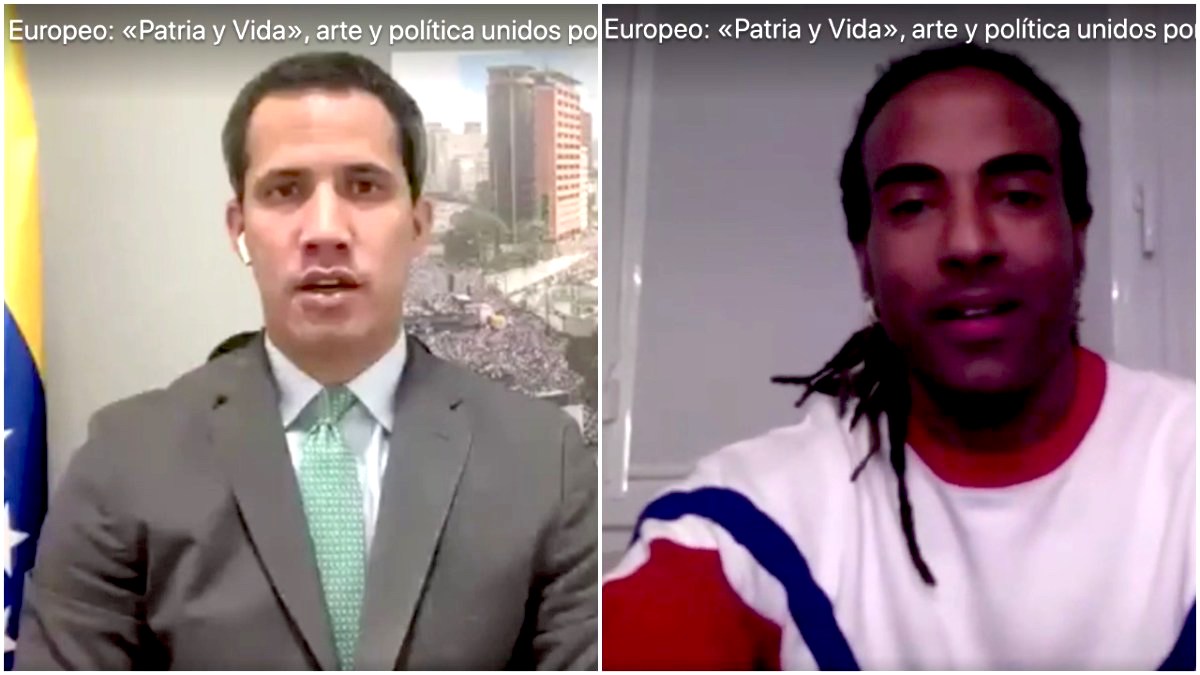
U.S.-backed Venezuelan coup leader Juan Guaidó appeared alongside Yotuel to celebrate the release of “Patria y Vida” in the EU parliament. (The Grayzone)
As this investigation will reveal, leading members of the San Isidro Movement have raked in funding from regime change outfits like the National Endowment for Democracy and U.S. Agency for International Development while meeting with State Department officials, U.S. embassy staff in Havana, right-wing European parliamentarians and Latin American coup leaders from Venezuela’s Guaidó to OAS Secretary General Luis Almagro.
San Isidro has also welcomed support from a network of free market fundamentalist think tanks which make no secret of their plan to transform Cuba into a colony for multi-national corporations. Days after protests broke out in Cuba, San Isidro’s leadership accepted an award from the Victims of Communism Memorial Foundation, a right-wing Republican think tank in Washington that includes Nazi German soldiers in its count of historic deaths at the hands of communism.
Behind their branding as cosmopolitan intellectuals, renegade rappers, and avant garde artists, San Isidro has openly embraced the extremist politics of the Miami Cuban lobby. Indeed, its most prominent members have expressed effusive support for Donald Trump, endorsed U.S. sanctions and clamored for a military invasion of Cuba.
The cultural collective has nonetheless made inroads into progressive circles of North American intelligentsia, working to weaken traditional bonds of solidarity between the Cuban revolution and U.S. left. As we will see, the rise of the San Isidro Movement is the latest chapter in the emerging playbook of intersectional imperialism.
‘Forgotten People’
The scenes of an overturned police car in Havana’s October 10 neighborhood, mobs pelting police officers with Molotov cocktails, and the looting of commercial centers this July 11 ripped the cover off the resentment of a class of citizens that has fallen through the cracks of Cuba’s beleaguered special economy.
Following years of deepening economic deprivation, Cubans have experienced blackouts and food rationing brought on by former President Donald Trump’s intensification of the 60-year-long U.S. economic blockade of Cuba. A sudden collapse in tourism due to the Covid-19 pandemic together with the government’s elimination of Cuba’s dual currency system exacerbated the economic chaos.
Cristina Escobar, a Havana-based journalist and one of the most widely watched news personalities on Cuba’s state broadcasting channel, described the protest rank-and-file to The Grayzone as the byproduct of sustained marginalization.
“There’s a group of people in urban places like Havana that have the following characteristics,” Escobar explained. “They’re usually from rural poor areas and have moved to the city looking for better opportunities; usually not white with all the gradients there, and live at the margins, receiving whatever state benefits that are available. They often work in informal economy, they feel disaffected and don’t have involvement in patriotic ventures because they’re the victims of the special period of poverty.”
While Cuba’s social safety net has prevented this demographic from slipping into the misery familiar to slums of IMF-managed states such as Haiti or Honduras, Escobar says “they are a forgotten group of people, disintegrated, without roots in society. They are expressing the inequality they experience and unfortunately, they are not doing it peacefully anymore.”
U.S. corporate media has seized on the images of Afro-Cuban protesters to paint the demonstrations as an expression of explicitly racialized discontent. In an article headlined, “Afro Cubans at forefront of [Cuba’s] unrest,” The Washington Post quoted anti-government NGO’s and activists associated with the San Isidro Movement denouncing Black Lives Matter for its statement of solidarity with the Cuban revolution.
Left unmentioned by The Washington Post was the role of the U.S. government in backing many of these same NGOs and activists in a bid to weaponize the Cuba’s underclass. At the forefront of Washington’s strategy are two traditional CIA fronts: the U.S. Agency for International Development (USAID) and the National Endowment for Democracy (NED).
Throughout the Cold War, USAID worked alongside the CIA to liquidate socialist movements across the Global South. More recently, it helped implement a phony CIA vaccination program in Pakistan to track down Osama bin Laden, and instead wound up spawning a massive polio outbreak. Across Latin America, USAID has funded and trained right-wing opposition figures, including Venezuela’s U.S.-appointed pseudo-president Juan Guaidó.
For its part, the NED was established under the watch of former CIA Director William Casey to provide support to opposition activists and media outlets wherever the U.S. has sought regime change. “A lot of what we do today was done covertly 25 years ago by the CIA,” NED co-founder Allen Weinstein told journalist David Ignatius, who celebrated the organization as “the sugar-daddy of overt operations.”
Throughout their history, USAID and NED have worked to exploit the grievances of ethnic minority groups against socialist and non-aligned governments. Their financial and logistical support for the Uyghurs against China, the Tatars against Russia, and indigenous Miskito people against Nicaragua are among many examples.
In recent years in Cuba, Washington’s regime-change specialists have homed in on Afro-Cubans and marginalized youth, harnessing culture to turn social resentment into counter-revolutionary action.
Weaponizing ‘De-socialized’ Youth
A 2009 paper in The Journal of Democracy, the official organ of the NED, outlined an ambitious blueprint for cultivating Cuba’s post-Cold War underclass as an anti-government vanguard.
“Using the principles of democracy and human rights to unite and mobilize this vast, dispossessed majority in the face of a highly repressive regime is the key to peaceful change,” wrote Carl Gershman and Orlando Gutierrez.
Gershman and Gutierrez are influential figures in the world of overt regime change operators. The founding director of the NED, Gershman presided for four decades over U.S. efforts to destabilize governments from Managua to Moscow. Gutierrez, for his part, is an outspoken advocate of a U.S. military invasion of Cuba who serves as national secretary of the USAID and NED-funded Cuban Democratic Directorate.
#UnitedStates | Orlando Gutiérrez Boronat, a Cuban-American based in South Florida, leads the organization. On December 4, Boronat expressed his support for an armed invasion of Cuba to overthrow the socialist government.https://t.co/pEbsGnYrBQ
— teleSUR English (@telesurenglish) December 9, 2020
Gershman and Gutierrez advised a strategy that encouraged “non-cooperation” with Cuba’s revolutionary institutions among those they described as “ ‘desocialized’ and marginal youth – the dropouts, the jobless young people who make up nearly three-quarters of Cuba’s unemployed, and those who are drawn to drugs, crime, and prostitution.”
The two regime-change specialists pointed to music and online media as ideal vehicles for harnessing the frustrations of Cuban youth: “The alienation of the young reaches into the mainstream and expresses itself in the angry lyrics of rock musicians; the bloggers’ depictions of the frustrations and tawdriness of everyday life; the frequent evasion of agricultural work, voluntary service, and neighborhood committee meetings; and the general disengagement from politics that is the fruit of a half-century of coerced participation and force-fed political propaganda,” they wrote.
The year that Gershman and Gutierrez’s influential paper appeared, Washington enacted an audacious covert operation based on the strategy they outlined.
‘Rap is War’
In 2009, USAID initiated a program to spark a youth movement against Cuba’s government by cultivating and promoting local hip-hop artists.
Because of its long history as a CIA front, USAID outsourced the operation to Creative Associates International, a Washington, D.C.-based firm with its own track record of covert actions.
Creative Associates found its point man in Rajko Bozic, a veteran of the CIA-backed Otpor! group that helped topple nationalist leader Slobodan Milosevic, and whose members moved on to form an “‘export-a-revolution’ group that sowed the seeds for a number of color revolutions.”
Posing as a music promoter, Bozic approached a Cuban rap group called Los Aldeanos that was known for its ferociously anti-government anthem, “Rap is War.” The Serbian operative never told Los Aldeanos he was a U.S. intelligence asset; instead, he claimed he was a marketing professional and promised to turn the group’s front man into an international star.
To further the plan, Creative Associates rolled out ZunZuneo, a Twitter-style social media platform that blasted out thousands of automated messages promoting Los Aldeanos to Cuban youth without the rap group’s knowledge.
Within a year, as Los Aldeanos escalated its rhetoric, taunting Cuban police as mindless drones during a local indie music festival, Cuban intelligence discovered contracts linking Bozic to USAID and rolled up the operation.
Embarrassment ensued in Washington, with Sen. Patrick Leahy grumbling, “U.S.AID never informed Congress about this and should never have been associated with anything so incompetent and reckless.”
Danny Shaw, an associate professor of Latin American and Caribbean Studies at the City University of New York, encountered Los Aldeanos during several extended visits to Cuba. He also got to know Omni Zona Franca, a collective of poets and Rastafarian-oriented performance artists based in the Alamar neighborhood of Havana which formed the inspiration for the San Isidro Movement.
Shaw said the artists’ hostility towards Cuba’s socialist system was so intense that many of them denied the U.S. blockade’s existence. “I tried to explain to them my understanding of the economic war, and they said, ‘You can come and go as you please, you don’t live here, so it’s easy for you to be a Marxist.’ And they had a point – if you completely decontextualized the situation,” he told The Grayzone.
According to Shaw, some Omni Zona Franca members began visiting the U.S. and Europe for art festivals and interviews with corporate Spanish-language media. “When the stories about USAID supporting Cuban rappers and artists came out, then it all kind of made sense to me,” he reflected.
In 2014, USAID was exposed again when it tapped Creative Associates to organize a series of phony HIV prevention workshops which were, in fact, political recruitment seminars.
An internal Creative Associates document leaked to the media in 2014 referred to the bogus HIV workshops as the “perfect excuse” to enlist youth into regime change activities on the island.
President Barack Obama introduced his plan to normalize relations with Cuba’s government just as U.S.AID’s latest operation was exposed. As a condition of diplomatic recognition, Obama insisted that Cuba expand internet access.
Venezuelan investigative website Misión Verdad warned at the time,
“We are witnessing an update in the mechanisms, methods and modes of intervention. All the harmony at this time is totally illusory. What is already being placed under the label ‘normalization’ in the Cuban sociopolitical environment provides the minimum operating conditions to facilitate the idea of a ‘Cuban spring,’ a test tube revolution…”
Internet Expansion & US Infiltration
The 3G internet network arrived in Cuba in 2018, enabling young Cubans to access social media on their phones. Now, instead of spinning out social media platform like ZunZuneo, U.S. intelligence focused on developing technology like Psiphon so Cubans could access Facebook and YouTube despite internet blackouts.
The NED and USAID exploited the opening to build a potent online anti-government media apparatus. The new batch of U.S.-backed outlets like CubaNet, Cibercuba and ADN Cuba represented an echo chamber of toxic insurrectionism, mocking President Miguel Diaz-Canel with insulting memes and calling for his prosecution for high crimes including genocide.
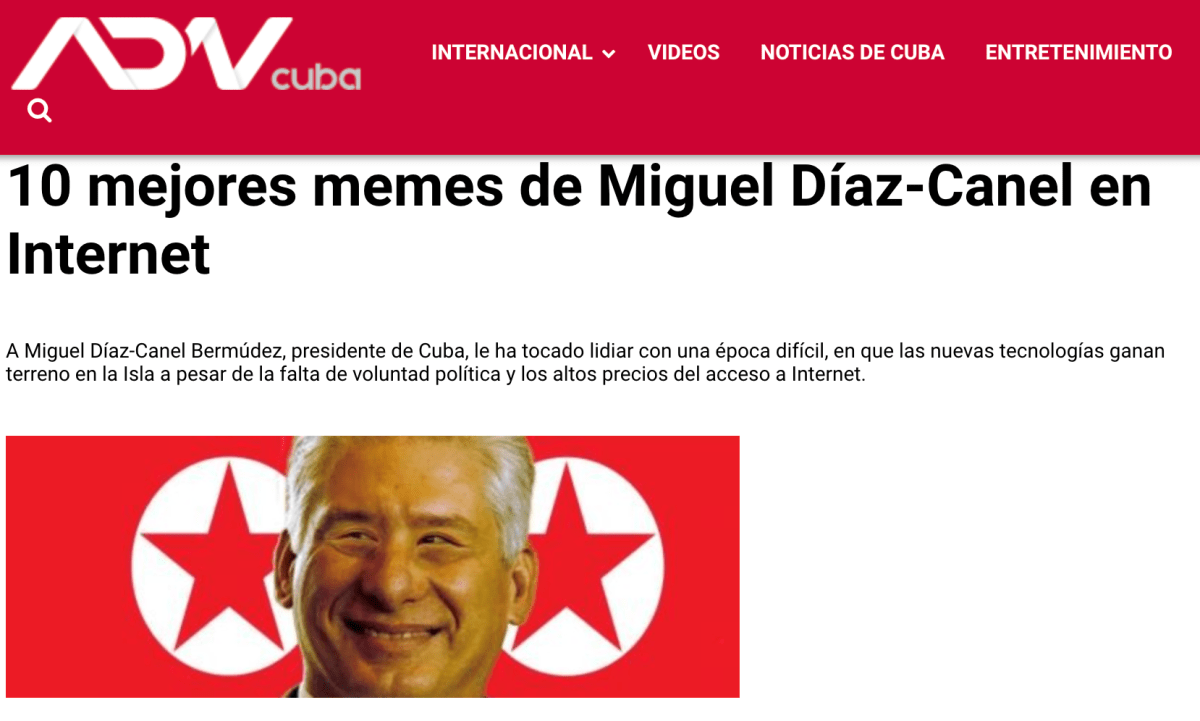
ADN Cuba mocks Diaz-Canel by merging his face with that of North Korean leader Kim Jong-un. (The Grayzone)
The Dutch Foreign Ministry has advanced the U.S. efforts, helping to set up and fund the anti-government blog, El Toque, through an NGO called RNW Media.
Ted Henken, a U.S. academic and author of Cuba’s Digital Revolution, remarked to Reuters that Cuba’s leadership “miscalculated in that they didn’t realize that [expanded internet access] would very quickly, in two and a half years, blow up in their face.”
“None of [the protests] would have been possible without the nascent 3G network that has allowed millions of Cubans to access the internet via mobile devices since 2018,” the corporate online outlet Quartz declared.
As Cuban access to anti-government media grew, the Trump administration increased NED’s budget by 22 percent in 2018.
That year, NED’s Cuba budget earmarked close to $500,000 for the recruitment and training of anti-government journalists, and to establish new media outlets.
Another NED grant budgeted funds to “promote the inclusion of marginalized populations in Cuban society and to strengthen a network of on-island partners,” implying the targeting of Afro-Cubans.
The NED has placed a heavy emphasis on infiltrating Cuba’s hip-hop scene. In 2018, the U.S. government entity contributed $80,000 to the Cuban Soul Foundation to “empower independent artists to produce, perform, and exhibit their work in uncensored community events,” and $70,000 to a Colombia-based NGO called Fundacion Cartel Urbano for “empowering Cuban hip-hop artists as leaders in society.”
Cartel Urbano publishes an online magazine clearly modeled off of Vice, the premier vehicle for hipster imperialism. Besides keeping readers informed about the latest releases from anti-government Cuban rap artists, the U.S. government-funded magazine dedicates entire sections on its website to drug use, trans culture and the green vegan lifestyle.
In catering to the sensibilities of academically oriented, self-styled radicals, the outlet’s writers routinely deploy the letter “x” to erase gender distinctions, leading to passages like the following: “cuerpxs trans, marikonas, no binarixs, racializadxs, monstruosxs…”

Cartel Urbano is sponsored by the U.S. government to train and promote Cuban hip-hop artists. (The Grayzone)
The startling proliferation of online opposition media, vitriolic anti-government propaganda, and U.S. infiltration of Cuba’s cultural scene that accompanied the expansion of the country’s internet services prompted an unprecedented crackdown by the country’s leadership.
“The years when we had the thawing of relations with the U.S., we had so much tolerance domestically,” Cristina Escobar, the Cuban journalist, reflected. “That’s because the government did not see itself as under siege. But then Trump won. And now the leadership feels like they should have never trusted Obama.”
Just hours after taking office in April 2018, President Diaz-Canel proposed Decree 349. The new measure would require that all artists, musicians and performers obtain prior approval from the Ministry of Culture before publicizing their work.
Put forward in direct response to the recruitment of rap artists and other cultural figures by U.S. intelligence, Decree 349 explicitly forbade the dissemination of audiovisual materials containing “sexist, vulgar or obscene language.” Though the law would never be enforced on a formal basis, the provision was viewed by Cuba’s opposition as a direct attack on the subculture of reggaeton seeping into the country’s urban landscape.
Almost overnight, a collective of artists and musicians mobilized to protest the decree. Named for the hardscrabble San Isidro neighborhood in Old Havana where several of its members lived, the new movement appealed directly to cultural influencers in the Global North, marketing itself as a diverse collection of visual creators and independent rappers struggling for nothing more than artistic freedom.
For perhaps the first time, Cuba’s right-wing opposition had a vehicle for making inroads into progressive circles abroad.
Courting Celebrity
On Nov. 6, 2020, a police officer appeared in the home of Denis Solis, an outspoken anti-government rapper affiliated with the San Isidro Movement. Solis quickly turned his cellphone camera on the cop and livestreamed his defiant encounter on Facebook.
After taunting the officer with anti-gay slurs, Solis proclaimed, “Trump 2020! Trump is my president!”
The police visit was triggered by the excited coverage Solis received from Diario de Cuba, a NED-funded publication, and other anti-government outlets, for a tattoo emblazoned across his chest that read, “Change; Cuba Libre.” He had also taken to Facebook to boast, “Communists, now they’re going to have to tear the skin from my chest.”
The eight-month prison sentence Solis received for “contempt” — a punishment clearly inspired by the spectacle he generated with his livestream – provided the spark for the November 2020 hunger strike that vaulted the San Isidro Movement onto the global stage.
The strike was held inside the Old Havana home of the San Isidro Movement’s coordinator, Luis Manuel Otero Alcántara. An Afro-Cuban performance artist, Otero has courted the ire of the government by defiling the Cuban flag, wrapping it around his naked torso on the toilet and while brushing his teeth, or by sprawling out on it while clad in underwear bearing the U.S. flag.
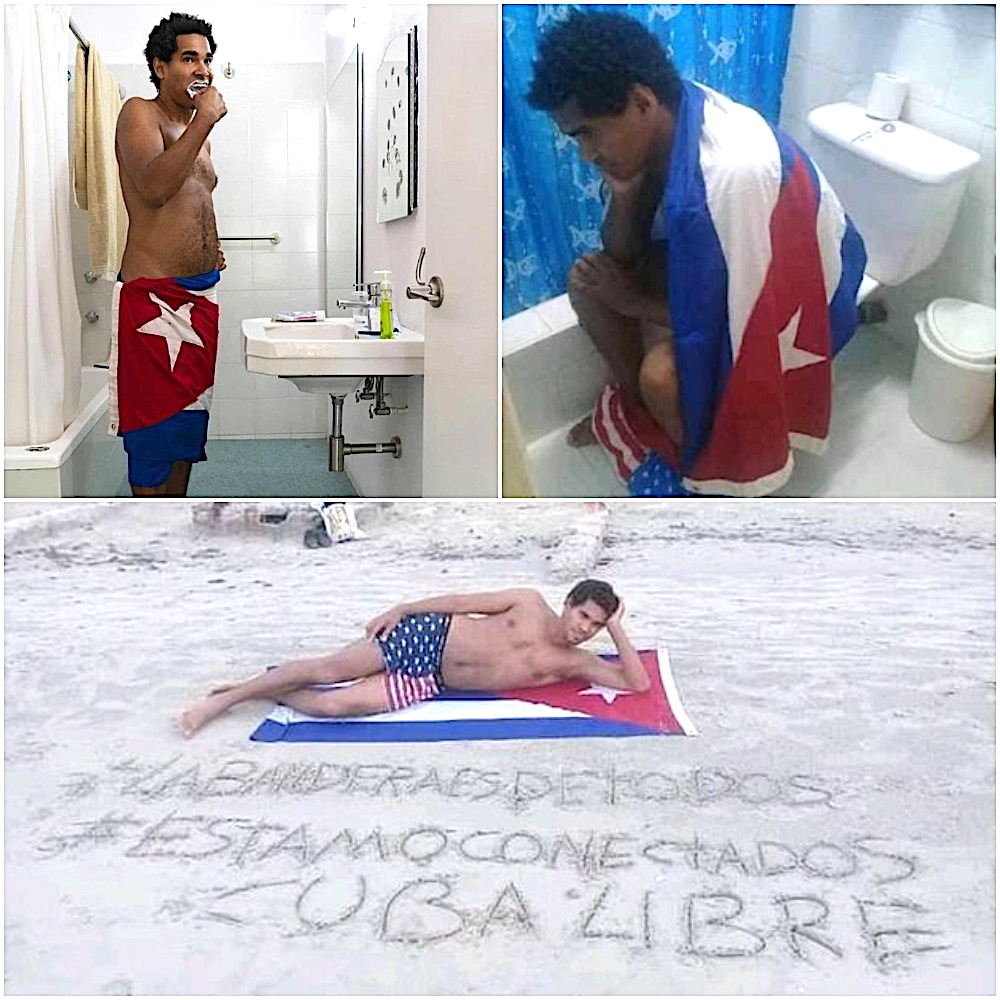
The art of San Isidro Movement coordinator Luis Manuel Otero Alcántara. (The Grayzone)
In another provocative display, Otero gathered children to run through his neighborhood waving a giant American flag, triggering an immediate police response and his own detention for four days.
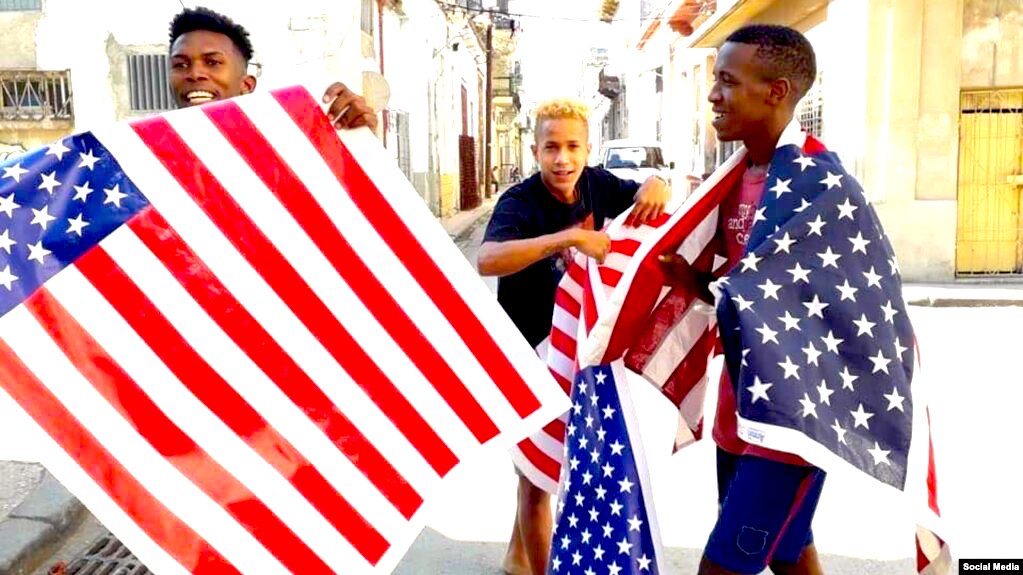
Luis Manuel Otero Alcántara enlisted Cuban youth to run through Old Havana bearing U.S. flags. (The Grayzone)
The week-long hunger strike at Otero’s home generated an unprecedented international media spectacle, and generated supportive statements from Jake Sullivan, the Biden administration’s incoming national security adviser, and then-Secretary of State Mike Pompeo.
We urge the Cuban regime to cease harassment of San Isidro Movement protestors and to release musician Denis Solís, who was unjustly sentenced to eight months in prison. Freedom of expression is a human right. The United States stands with Cuba’s people.
— Secretary Pompeo (@SecPompeo) November 24, 2020
A cleverly staged visit to the site of the hunger strike by Carlos Manuel Álvarez, a high-profile Mexico-based Cuban journalist and literary figure, had helped galvanize international media interest.
Clad in a black turtleneck and hailing from the ranks of Cuba’s educated elite, the bespectacled Álvarez presented a stark contrast to Otero and his rugged wingman, the anti-government rapper Maykel Osorbo. For governing officials tempted to dismiss the protest leaders as a bunch of vulgar street urchins, the figure of the genteel scribe presented serious complications.
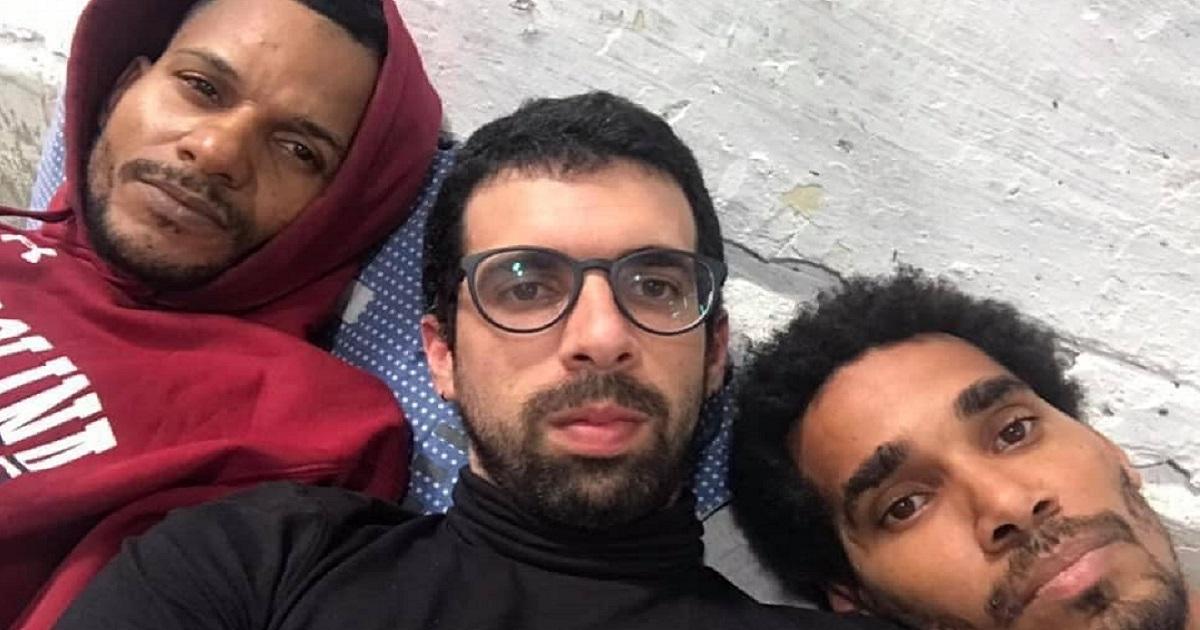
Journalist Carlos Manuel Álvarez, center, with Luis Miguel Otero, on right, and rapper Maykel Osorbo. (The Grayzone)
Álvarez soon found space in The New York Times opinion section to market San Isidro to a liberal U.S. audience while rattling off literary metaphors about walking over cobblestone in high-heeled shoes to denigrate Cuba’s communist bureaucracy.
“The [San Isidro] movement has become the most representative group of national civil society, bringing together Cubans of different social classes, races, ideological beliefs and generations, both from the exile community and on the island,” the writer claimed.
On Nov. 27, 2020, as the confrontation between Cuban artists and the state deepened, a group of artists initiated a sit-in outside Cuba’s Ministry of Culture. The original demonstrators consisted largely of artists whose work had been sponsored by the Cuban state. And unlike San Isidro, many of them rejected regime change rhetoric, opting instead for a dialogue with the culture minister to resolve the conflict over freedom of expression.
As sociologist Rafael Hernandez explained in a detailed study of the sit-in, the dialogue collapsed when the San Isidro Movement and other U.S.-backed elements imposed their maximalist agenda on the organizing body, which came to be known as N27.
The New York Times and other other Anglo outlets focused their coverage squarely on the anti-communist rabble rousers of San Isidro, while leftist Cuban artists “remained invisible to the foreign press, which does not consider them news, as it does the veteran and youth dissidents,” Hernandez observed.
The intensive media coverage of the sit-in vaulted the San Isidro Movement onto the international stage, earning them the attention of celebrity artists and writers in the U.S. and Europe.
In May 2021, after Otero was again detained by Cuban security, an open letter to President Diaz-Canel appeared in The New York Review of Books, a leading journal of the liberal U.S. literati, demanding his release.
Signed by a cast of prominent Black and Afro-Latin cultural figures, including Henry Louis-Gates, Edwidge Danticat and Junot Diaz, the missive illustrated the success San Isidro was enjoying in eroding the support of Black American intelligensia for Cuba’s revolution.
With access to the leading liberal organs of U.S. media and support in Latin American studies departments across the country, the cultural collective was breaking Cuba’s anti-communist opposition out of its traditional right-wing Miami base.
But its success was hardly an organic phenomenon. Indeed, San Isidro had been propelled onto the international stage thanks to substantial support from the U.S. State Department, its regime change subsidiaries and right-wing corporate lobbyists eager to see Cuba open up for business.
State Department, OAS & Corporate Lobbyists
Each day at the El Estornudo magazine he founded, Carlos Manuel Álvarez and his colleagues present the bad news from Cuba. While painting the country as a catastrophically-run communist hellscape overrun with Covid-19 casualties, he markets his outlet as “independent.”
In reality, El Estornudo appears to be one of the many media projects incubated by the National Endowment for Democracy (NED).
“The collaborators who make the magazine are paid per work produced, with a fixed salary of 400 CUC. Until I left, El Estornudo was financed by the NED and Open Society [foundations],” said Abraham Jiménez Enoa, a former writer for the magazine, referring respectively to the U.S. government’s regime change arm and the foundation of George Soros.
El Estornudo is among a constellation of outlets delegated to criticize Cuba’s Covid response by the Institute for War and Peace Reporting (IWPR), an NGO that received $145,230 from the NED in 2020 to “strengthen collaboration among Cuban independent journalists” and train them in social media.
The anti-government outlets operating under the auspices of IWPR also include Tremenda Nota, an LGBTQ-themed site that routinely accuses the Cuban government of homophobia and transphobia, even as the Diaz-Canel administration has moved to legalize gay marriage, opened the army to gay soldiers and initiated official pride events.
IWPR’s board is comprised of former NATO officials and corporate media figures, including the former chair of The Financial Times. Though the NGO has since scrubbed its list of patrons from its website, an archived page reveals partnerships with the NED and its U.S. government subsidiaries, as well as confirmed British intelligence contractors like Albany Associates and the Thomson Reuters Foundation.
Carlos Manuel Álvarez is far from the only San Isidro member close to U.S. regime change entities. Besides him, there is Yaima Pardo, a Cuban filmmaker and tech specialist whose 2015 documentary, Offline, emphasized the need for internet expansion to foment dissent.
Pardo is currently the multi-media director for ADN Cuba, a Florida-based anti-government outlet that received $410,710 from USAID in 2020 alone.
San Isidro’s Esteban Rodríguez, a reporter for ADN Cuba, has celebrated the economically debilitating ban Trump imposed on family remittances to Cuba as “perfect.” “If I was in the U.S., I’d have voted Trump,” Rodríguez told The Guardian.
When San Isidro launched its international campaign against Decree 349, it chose to do so at the Organization of American States (OAS) – the Washington, D.C.-based regional organization derided by former Cuban Foreign Minister Raúl Roa as “the Yankee ministry of the colonies.”
There, San Isidro co-founder Amaury Pacheco was received by Luis Almagro, the OAS secretary-general who would help orchestrate the right-wing military coup in Bolivia later that year. Also on hand to welcome the Cuban artists were State Department officials and Carlos Trujillo, a right-wing Trump loyalist serving as the U.S. representative to the OAS.
“Art in Cuba is more necessary than ever,” Almagro proclaimed. “It is necessary to expose the challenges of repression” by the Cuban state.
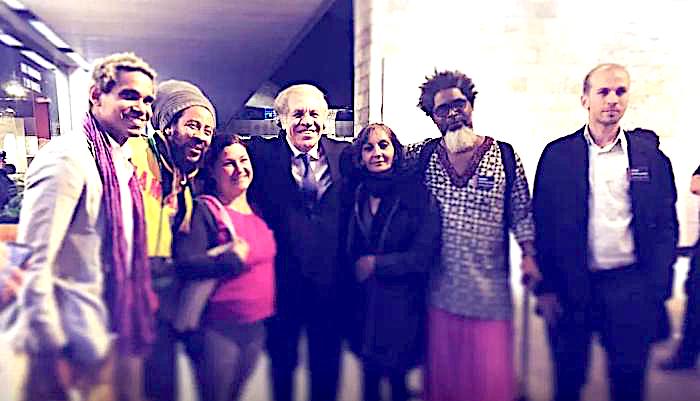
OAS Secretary-General Luis Almagro with San Isidro Movement co-founder Amaury Pacheco (second from right) and other artists affiliated with the collective. (The Grayzone)
As the Venezuela-based Instituto Samuel Robinson reported, San Isidro has deepened its ties with the international right-wing through the CADAL foundation, which nominated it for the NATO state-sponsored Freemuse Prize for Artistic Expression. CADAL is at the heart of a network of libertarian organizations that leverage corporate money to push free market fundamentalism across Latin America.
Among CADAL’s closest partners is the Atlas Network, a corporate lobbying front established with help from the Koch Brothers to advance libertarian economics and undermine socialist governments across the globe.
The think tank is also sponsored by the U.S. State Department, the NED, and its subsidiaries, including the Center for International Private Enterprise, which devotes itself to “strengthening democracy around the globe through private enterprise and market-oriented reform.”
In January 2021, leading members of San Isidro including Otero and Pardo participated in a webinar hosted by another corporate-backed, right-wing think tank. This time, they were guests of the Latin American Center of Federalism and the Freedom Foundation.
Sponsored by multi-national corporations determined to transform Cuba into a free-market haven, and inspired by the philosophy of Ayn Rand, the Argentina-based foundation is also directly affiliated with the Atlas Network.
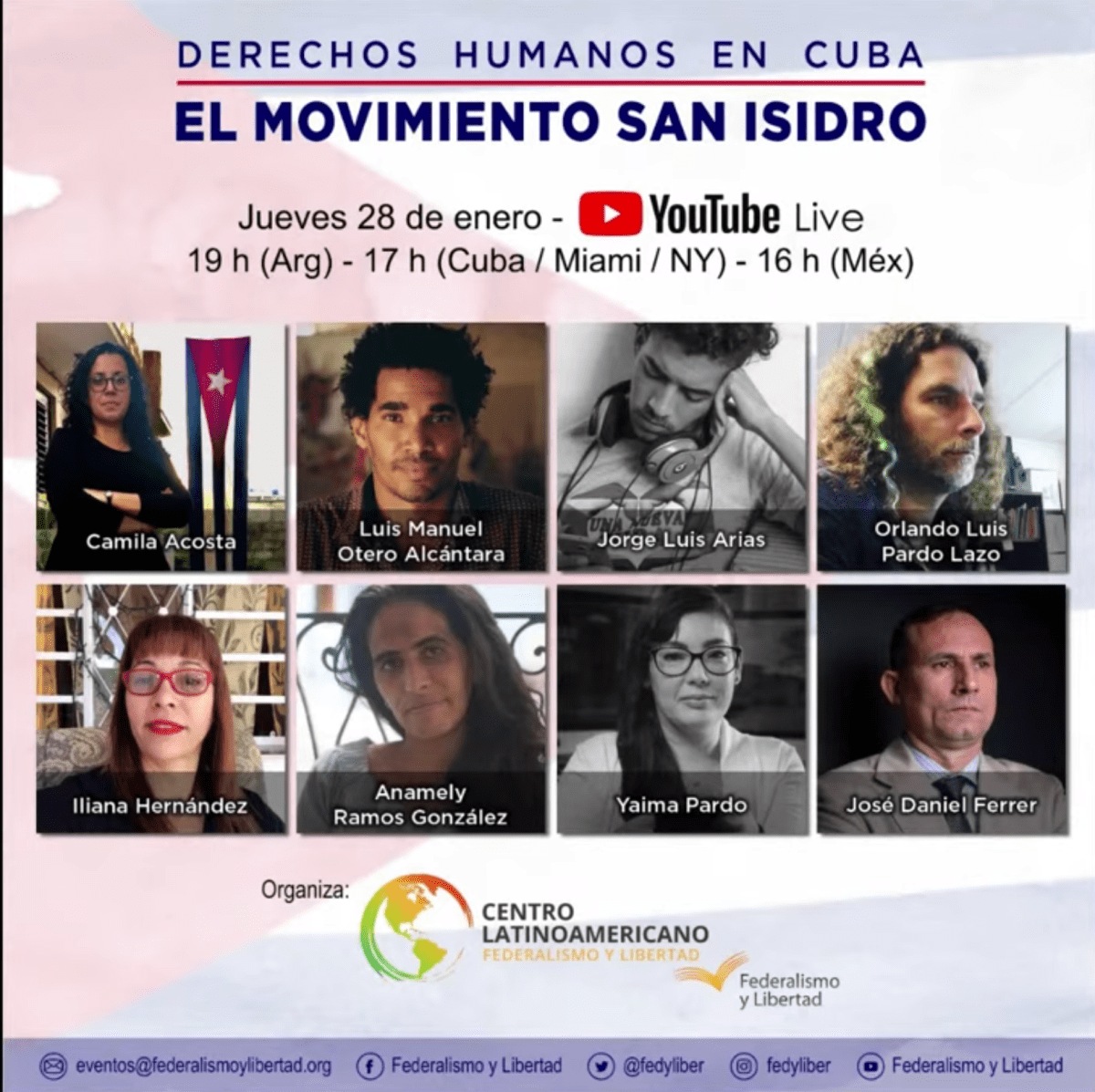
Among the participants in the webinar was Iliana Hernandez, a reporter for Cibercuba – one of the many anti-government outlets that cropped up in recent years following the expansion of internet services.
In a November 2020 discussion about the U.S. election on her Facebook page, Hernandez argued that because Trump was “going to take harsher measures against the tyranny… I think that, for Cuba’s freedom, Trump should win.”
She also detailed extensive coordination between the San Isidro Movement and State Department officials serving at the U.S. Embassy in Havana.
Referring to her discussions with the hardline U.S. Charges d’Affaires Timothy Zúñiga-Brown and his predecessor, Mara Tekach, Hernandez remarked, “In this last conversation with Mr. Tim [Zúñiga] Brown, what he told me was, ‘how can we be of help?’ Meaning, what can we do? Because, I mean, he wanted to get orders from me and not the other way around. I told him how he could help.”
Otero has also nurtured close relations with U.S. State Department officials. In July 2019, he and other San Isidro members strutted proudly around the U.S. ambassador’s residence in Havana during an event commemorating U.S. Independence Day.
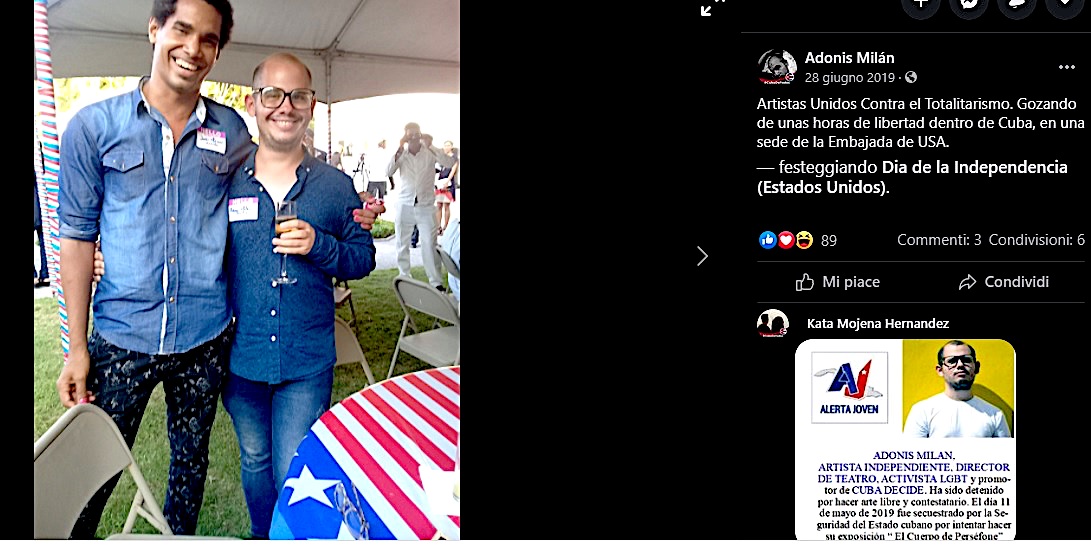
Otero and Milan of San Isidro celebrating Independence Day inside the U.S. ambassador’s residence. (The Grayzone)
Adonis Milan, a Havana-based theater director affiliated with San Isidro, posted photos on Facebook of himself, a reggae artist and San Isidro member named Sandor Pérez Pita, and Otero “enjoying a few hour of freedom inside Cuba” while snapping selfies with U.S. Marines.
“Viva la anexión,” Milan wrote in a post expressing his “fervent passion for the beautiful gringa.”
Asked by a reporter about a meeting he held on a Havana street with former U.S. Chargé d’affaires Tekach, Otero responded, “She is a diplomat. I can meet with Mara Tekach or the French ambassador; my friend, the ambassador from the Netherlands, or the one from the EU. Even with the Cuban President, Miguel Diaz-Canel, if one day he would like to talk to me.”
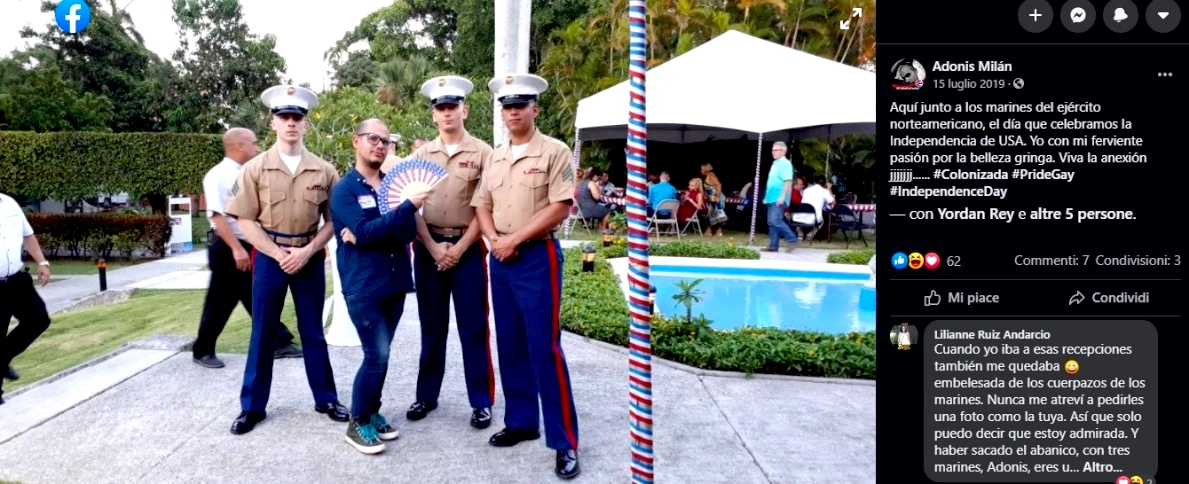
Adonis Milan captioned his portrait with U.S. Marines: “Long live annexation.” (The Grayzone)
In April 2021, the Cuban government claimed to have uncovered documents revealing payments of $1,000 a month to Otero from the National Democratic Institute, a subsidiary of NED. The accusations surfaced just as the artist planned to exhibit paintings of candy wrappers at his home and invite local children to view them, teasing the kids with the sweet life socialism had denied them. He flatly denied taking any payments from U.S. government regime change outfits.
By this point, Otero had become a star in a collaborative viral anthem that had provided Cuba’s counter-revolution with a unifying slogan and protest soundtrack.
‘Patria y Vida’
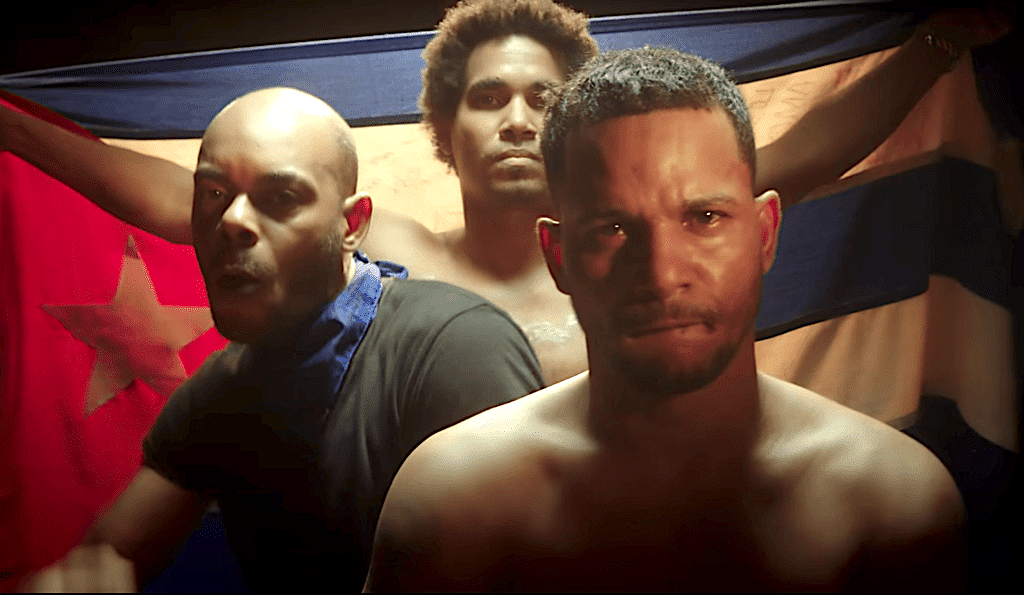
San Isidro members Maykel Osorbo, and El Funky, right, flank Otero Alcántara in the video of “Patria y Vida.” (The Grayzone)
The first song directly credited with mobilizing Cubans to protest their government was recorded by a collection of rappers and reggaeton artists that included two members of the San Isidro Movement.
Hailed by U.S. state media outlet NPR as “the song that’s defined the uprising in Cuba,” “Patria y Vida” has racked up over 7 million views since it debuted on YouTube on February 16, 2021
Recorded in Miami, the song features three self-exiled Cuban performers: Yotuel of the Orishas hip-hop group, the reggaeton duo Gente de Zona, and singer-songwriter Descemer Bueno. They were complimented by two Havana-based San Isidro Movement members: hip-hop artists El Funky and Maykel “Osorbo” Castillo.
Osorbo has proclaimed that he would “give [his] life for Trump” if the U.S. president imposed a total blockade on Cuba with “the coasts blocked, that nothing enters in, nor anything goes out… as they did in Venezuela.”
The video for “Patria y Vida” opens with the curious image of anti-colonial Cuban hero Jose Marti merging into that of U.S. founding father and settler-colonial slave owner George Washington.
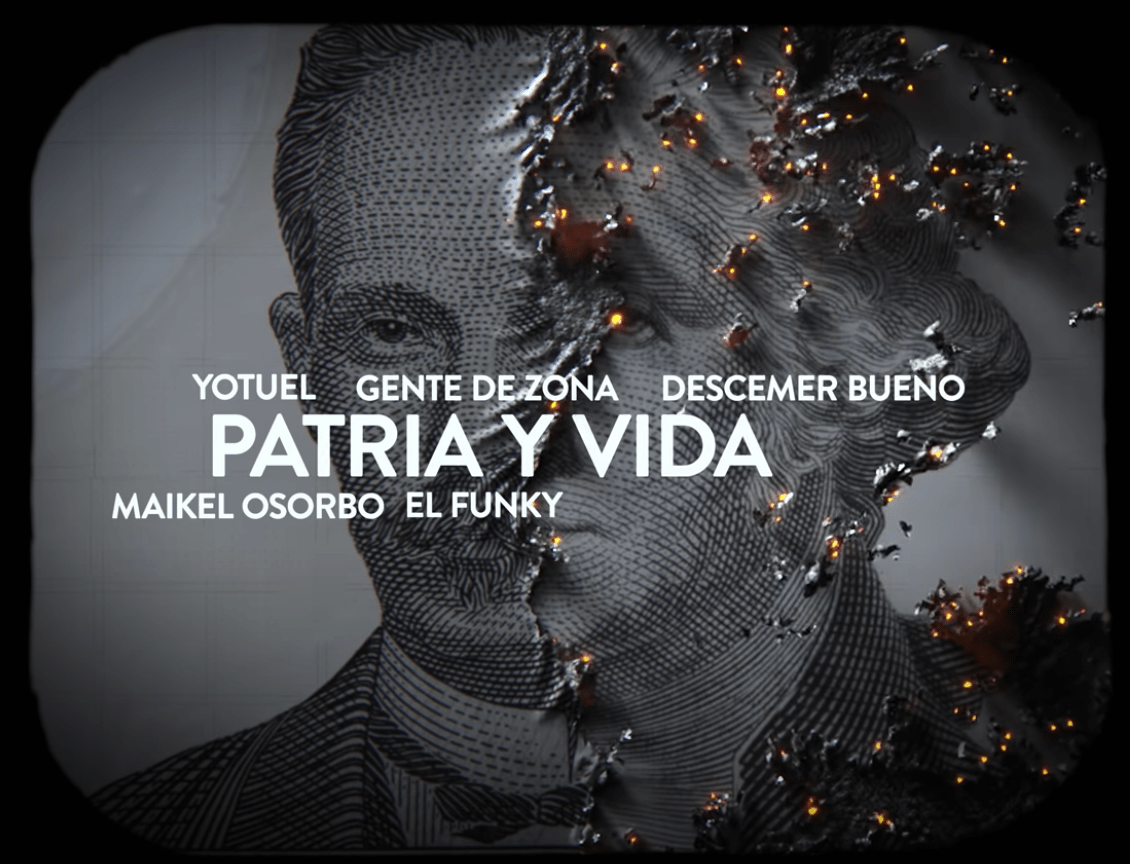 At the song’s climax, rappers Osorbo and El Funky appear on screen flanked by San Isidro’s Otero. Claiming to have filmed their performance surreptitiously, the rappers nonetheless appear in high-quality video chanting “Patria y Vida!”
At the song’s climax, rappers Osorbo and El Funky appear on screen flanked by San Isidro’s Otero. Claiming to have filmed their performance surreptitiously, the rappers nonetheless appear in high-quality video chanting “Patria y Vida!”
This slogan was an overt twist on Cuba’s revolutionary mantra, “Patria o Muerte,” which was first uttered by Fidel Castro at a memorial for dockworkers killed by the CIA’s deadly sabotage of the La Coubre freighter in Havana harbor in 1960. By reversing Castro’s vow to defend Cuba’s sovereignty with his life, the song’s authors take aim at the anti-imperialist political culture instilled in Cubans throughout the course of six decades.
Osorbo and El Funky’s verses mix lacerating attacks on the socialist government with tributes to San Isidro:
“We continue going in circles, security, deflecting with prism
These things make me indignant, the enigma is over
Enough of your evil revolution…”
Just one week after the song’s release, incoming USAID director Samantha Power took to Twitter to trumpet “Patria y Vida” as a reflection of a “new generation of young people in Cuba & how they are pushing back against govt repression.”
Such an interesting look at the new generation of young people in #Cuba & how they are pushing back against govt repression. A group of artists channeled their frustrations into a wildly popular new song that the government is now desperate to suppress. https://t.co/47RGc9ORuR
— Samantha Power (@SamanthaJPower) February 24, 2021
While Power is not especially known as a hip-hop connoisseur, she has earned a reputation for creating failed states in places like Libya by orchestrating humanitarian interventionist military campaigns. It is hard to imagine that her sudden interest in a viral Cuban rap anthem was not guided by a dedication to regime change on the island.
The European Parliament’s center-right European People’s Party Group also rallied to promote “Patria y Vida” just one week after its release. In Brussels, EU parliamentarian Leopoldo López-Gil – the oligarchic Spanish father of right-wing Venezuelan putschist Leopoldo López – helped host San Isidro Movement’s Otero, Yotuel, and several other figures behind the creation of “Patria y Vida.”
“I ask you today to condemn the Cuban government, so that my island has the strength to rise up…” Yotuel declared. “My people need Europe, my people need Europe to point out the abuser.”
Also on hand for the EU parliament event was Juan Guaidó, the U.S.-appointed faux “president” of Venezuela who launched a failed military coup alongside his mentor, Leopoldo López Jr.
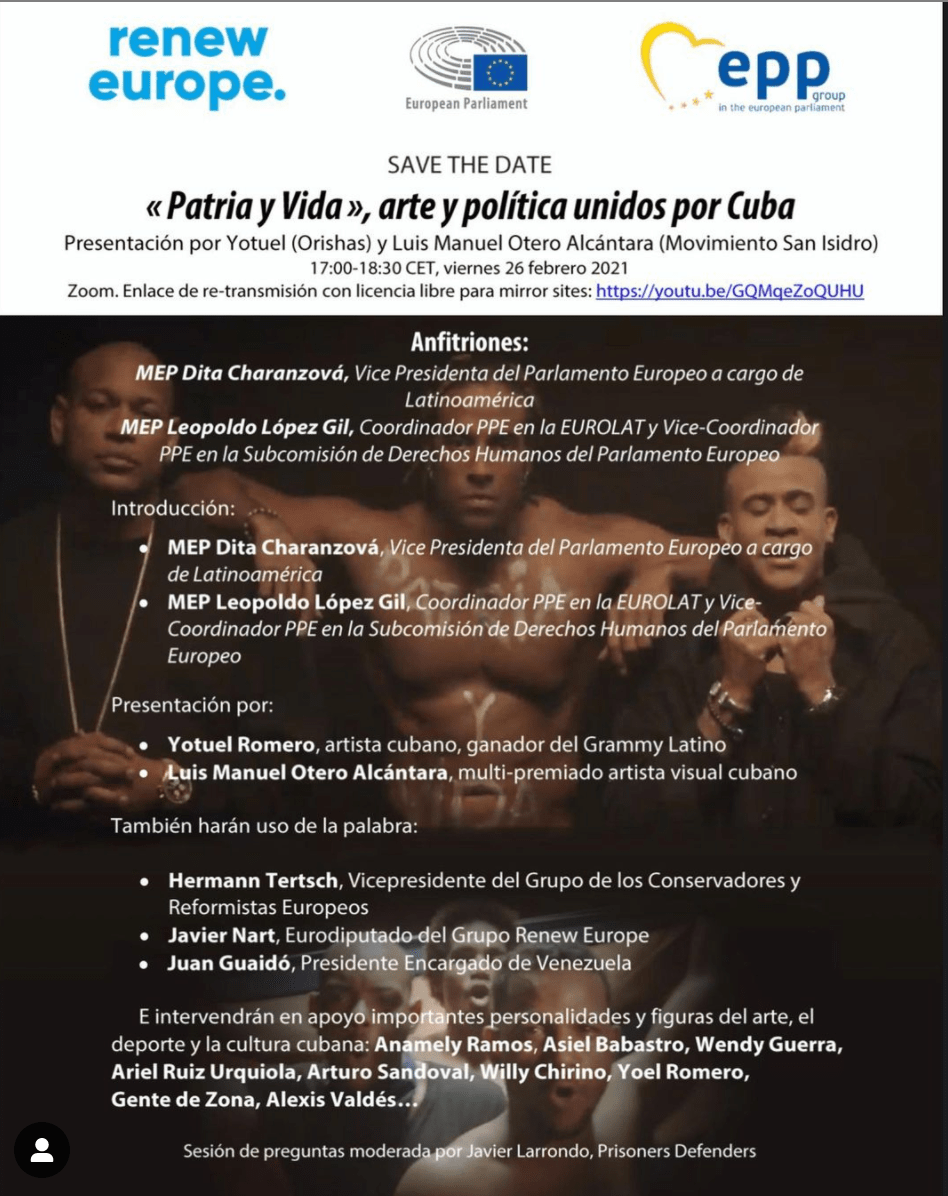 In the days that followed, the performers of “Patria y Vida” continued to make the regime change rounds. On March 12, Yotuel and Gente de Zona held a Zoom call with State Department officials, briefing them about the success of the song and the demands of the San Isidro Movement.
In the days that followed, the performers of “Patria y Vida” continued to make the regime change rounds. On March 12, Yotuel and Gente de Zona held a Zoom call with State Department officials, briefing them about the success of the song and the demands of the San Isidro Movement.
Inspiring call today with @yotuel007, @GdZOficial, and @EsBeatrizLuengo, where State Department officials heard about the viral #PatriaYVida. pic.twitter.com/EhVTMW0ghC
— Julie Chung (@WHAAsstSecty) March 12, 2021
Three months later, as journalist Alan MacLeod reported, Power’s USAID issued a notice of $2 million in grant opportunities for “civil society” organizations seeking to advance regime change in Cuba.
Highlighting the agency’s longstanding strategy of exploiting the demographics hit hardest by U.S. sanctions, the document emphasized the need for programs that “support marginalized and vulnerable populations, including but not limited to youth, women, LGBTQI+, religious leaders, artists, musicians, and individuals of Afro-Cuban descent.”
In the document, USAID pointed to “Patria y Vida” as a propaganda victory that helped produce a “watershed moment” – and which foreshadowed the protests to come.
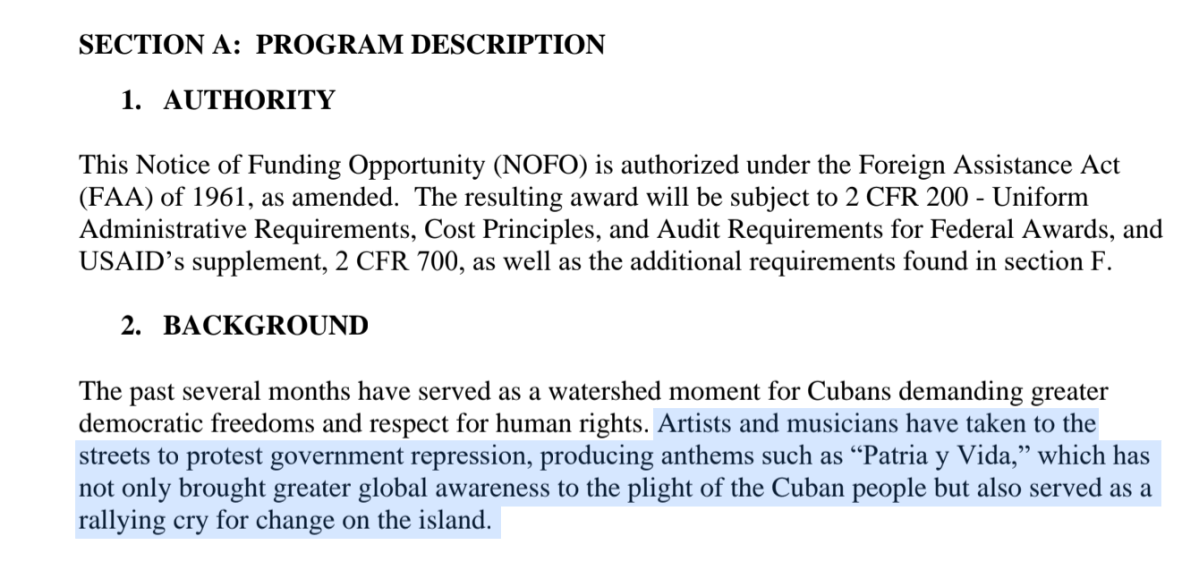
A June 2021 USAID appeal for grant proposals in Cuba singles out “Patria y Vida” as a major propaganda victory.
Less than a month later, on July 11, Otero issued a call to take to the streets of Havana on behalf of the San Isidro Movement. Soon, hundreds of protesters had gathered on the city’s seaside Malecon, some with signs reading “Patria y Vida.” The opposition’s vision of a national uprising capable of washing socialism away seemed to be coming into focus.
#11JCuba Luis Manuel Otero Alcántara y el Movimiento San Isidro convocan a los cubanos a salir a Malecón para reclamar libertad en La Habana pic.twitter.com/jN4vZHyZLK
— Mario J. Pentón (@MarioJPenton) July 11, 2021
An array of factors lay behind the protests, from the collapse of an electricity station in the city of Holguin, to the government’s sputtering attempts at currency unification, to the economic wounds opened by the U.S. blockade and kept festering by the special period of deprivation.
But through the culture warriors of San Isidro, now delegated by Washington as the official faces and voices of Cuba’s opposition, the demands of the demonstrators were interpreted as a maximalist cry for Washington to escalate its efforts at regime change.
San Isidro Movement Goes to Washington
Though the protests quickly fizzled out, remarks by President Joe Biden denigrating U.S.-embargoed Cuba as a “failed state,” and vowing to add new crushing sanctions to those imposed by Trump suggested the Democratic administration would not return to Obama’s process of normalization. A key short-term objective of the Miami regime change lobby was therefore achieved.
July 20 congressional hearings on Cuba in the House Foreign Affairs Committee highlighted the pivotal role San Isidro has played in the renewed push to topple Cuba’s government.
There, Rep. Debbie Wasserman-Schultz, a right-wing Democrat from South Florida, cited commentary by liberal academic Amalia Dache assailing Black Lives Matter for its statement of solidarity with the Cuban revolution. She then pointed to Afro-Cubans as an emerging base of anti-communist ferment on the island.
Several feet away sat Rep. Mark Green, a pro-Trump Republican, sporting a shirt emblazoned with the slogan, “Patria y Vida,” beneath his suit jacket.

U.S. Rep. Mark Green sports a “Patria y Vida” during a July 20 House Foreign Relations Committee hearing on Cuba. (The Grayzone)
That same day on Capitol Hill, the right-wing Victims of Communism Memorial Foundation honored the San Isidro Movement during its Captive Nations Week Summit.
In his remarks presenting the Dissident Human Rights award to the San Isidro Movement, Victims of Communism founder and veteran conservative movement operative Lee Edwards declared, “it isn’t always politics, but culture, which is so important in the battle we’re engaged in right now.”
Maykel Osorbo, the hip-hop artist who starred in “Patria y Vida,” accepted the award on behalf of San Isidro. “My brother, I want to thank you from the bottom of my heart,” he exclaimed in a pre-recorded message to the crowd of silver-haired, right-wing Republicans.
The editor-in-chief of The Grayzone, Max Blumenthal is an award-winning journalist and the author of several books, including best-selling Republican Gomorrah, Goliath, The Fifty One Day War and The Management of Savagery. He has produced print articles for an array of publications, many video reports, and several documentaries, including Killing Gaza. Blumenthal founded The Grayzone in 2015 to shine a journalistic light on America’s state of perpetual war and its dangerous domestic repercussions.
This article is from The Grayzone.
The views expressed are solely those of the author and may or may not reflect those of Consortium News.
Please Support Our
Summer Fund Drive!


Please explain why this is bad for Cuba and what reality they are courting. This is a fantastic article, so well investigated. But, it does not reveal the danger and trap that is awaiting these influenced and used people. They are too young to remember the years before their revolution.
I hope in the deepest corners of my Soul the Cuban people can see through this CIA backed faux revolution that it is totally an invention of the West!
Obama set it up and Trump expanded it!
See these tokens of the regime do work together. If only their brainwashed sheep knew how much!
Cuba’s probably going to have to get ruthless. Unfortunately, the world really would be better off without the US. Whenever we “help” some other country, remarkably a bunch of people die and they get a fascist dictatorship.
US0fA…a country that knows no shame.